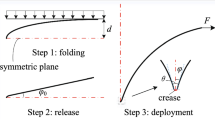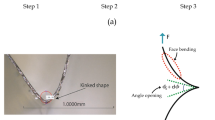Abstract
Aiming at the problem that the membrane structure is prone to creases in the process of folding and compaction, a proxy model is used to replace the creases to introduce initial defects for the folded membrane to realize the research of the deployment simulation of the membrane. Based on the finite-element method, the Z-folding and deploying process of the membrane is simulated and the elastic-plastic behavior of the crease is parameterized. The ABAQUS connector is used to replace the crease area of the membrane to simulate the characteristics of the crease and its effectiveness is verified. The deployment of Miura-ori membrane is simulated to explore the influence of force driving and constant-speed driving on the deploying process and deployment results of the membrane. In view of the self-contact phenomenon in the membrane deploying process when driven at a constant-speed, referring to the motion trajectory of the membrane loading corner of the force drive, a step-speed driving method is proposed. The research results show that using a step-speed to drive the deployment of folded membrane can reduce the curvature of the membrane surface, solve the problem of membrane self-contact, and eliminate the phenomenon of stress concentration of membrane surface. In addition, compared with other driving methods, the step-speed driving method has a significant advantage in improving the stability of the deploying process of a membrane.
Similar content being viewed by others
References
O. Mori et al., First solar power sail demonstration by IKAROS, Transactions of the Japanese Society for Artificial Intelligence, 8 (2011) 425–431.
A. Hossain, K. Woo and C. Jenkins, Nonlinear material response of systematically creased membranes, Proc. of 47th AIAA/ASME/ASCE/AHS/ASC Structures, Structural Dynamics, and Materials Conference, Rhode Island, USA (2006).
T. W. Murphey, A Nonlinear Elastic Constitutive Model for Wrinkled Thin Films, University of Colorado (2000) 1–133.
N. Okuizumi and T. Yamamoto, Centrifugal deployment of membrane with spiral folding: experiment and simulation, J. of Space Engineering, 2 (1) (2009) 41–50.
A. Gough et al., Experimental and numerical study of creased membranes, Proc. of 46th AIAA/ASME/ASCE/AHS/ASC Structures, Structural Dynamics, and Materials Conference, Texas, USA (2005).
K. Woo, K. Nandukar and C. H. Jenkins, Effective modulus of creased thin membranes, J. of Spacecraft and Rockets, 45 (1) (2008) 19–26.
J. Cai et al., Deployment simulation of foldable origami membrane structures, Aerospace Science and Technology, 67 (2017) 343–353.
A. C. Abbott et al., Characterization of creases in polymers for adaptive origami structures, Proc. of ASME 2014 Conference on Smart Materials, Adaptive Structures and Intelligent Systems SMASIS2014, Rhode Island, USA (2014).
Y. Xu and F. Guan, Fold methods and deployment analysis of deployable membrane structure, Engineering Mechanics, 5 (2008) 176–181.
N. Okuizumi, Numerical simulations of centrifugal deployments of membranes by spring-mass system models, Proc. of 51st AIAA/ASME/ASCE/AHS/ASC Structures, Structural Dynamics and Materials Conference, Florida, USA (2010).
B. Y. Dharmadasa and H. M. Y. C. Mallikarachchi, Simulation of neutral angle in thin folded membranes, Proc. of SSESL Annual Session, Colombo, Sri Lanka (2016).
K. Woo and C. H. Jenkins, Analysis of crease-wrinkle interaction for thin sheets, J. of Mechanical Science and Technology, 26 (3) (2012) 905–916.
S. Mierunalan and H. M. Y. C. Mallikarachchi, Prediction of creased geometry of thin folded membranes using finite element analysis, Proc. of Moratuwa Engineering Research Conference (MERCon), Moratuwa, Sri Lanka (2017).
Y. Satou and H. Furuya, Effects of elasto-plastic behavior of crease on deployed shape of space membrane, Proc. of AIAA Spacecraft Structures Conference, Florida, USA (2018).
N. Turner, B. Goodwine and M. Sen. A review of origami applications in mechanical engineering, J. of Mechanical Engineering Science, 230 (14) (2015) 2345–2362.
Y. Satou and H. Furuya, Mechanical properties of z-fold membrane under elasto-plastic deformation, J. of Space Engineering, 4 (4) (2011) 14–26.
F. Huang, Comparison of various evaluating methods for flatness error, Tool Engineering, 41 (8) (2007) 107–109.
K. A. Seffen and S. Pellegrino, Deployment of a Rigid Panel by Tape-springs, Cambridge University Department of Engineering (1997).
K. W. Kim and Y. Park, Solar array deployment analysis considering path-dependent behavior of a tape spring hinge, J. of Mechanical Science and Technology, 29 (5) (2015) 1921–1929.
F. Dewalque et al., Experimental and numerical investigation of the nonlinear dynamics of compliant mechanisms for deployable structures, Mechanical Systems and Signal Processing, 101 (2018) 1–25.
D. Y. Kim et al., Experimental and numerical investigation of solar panels deployment with tape spring hinges having nonlinear hysteresis with friction compensation, Applied Sciences, 10 (21) (2020) 7902.
A. Papa and S. Pellegrino, Systematically creased thin-film membrane structures, J. of Spacecraft and Rockets, 45 (1) (2008) 10–18.
A. Tessler, D. W. Sleight and J. T. Wang, Effective modeling and nonlinear shell analysis of thin membranes exhibiting structural wrinkling, J. of Spacecraft and Rockets, 42 (2) (2012) 287–298.
K. Miura, Method of packaging and deployment of large membranes in space, Proc. of Congress of International Astronautics Federation, Tokyo, Japan (1980).
Acknowledgments
This work was supported by National Natural Science Foundation of China (Project No. 51835002), Natural Science Foundation of Shanxi Province (Project No. 201901D211010) and Technology Innovation Foundation of Shanxi University (Project No. 2019L0177).
Author information
Authors and Affiliations
Corresponding author
Additional information
Youqing Shen studied at Taiyuan University of Technology, Taiyuan.
Jing Zhang, Ph.D., is an Associate Professor in Taiyuan University of Technology. Her research interests include design and analysis of folding mechanism and flexible mechanism.
Hongwei Guo, Ph.D., is a Professor in Harbin Institute of Technology. His research interests include space deployable mechanism and control, aircraft variant mechanism.
Rights and permissions
About this article
Cite this article
Shen, Y., Zhang, J., Guo, H. et al. Deployment simulation of membrane structures based on elastic-plastic behavior parameterization of the crease. J Mech Sci Technol 35, 2083–2095 (2021). https://doi.org/10.1007/s12206-021-0424-4
Received:
Revised:
Accepted:
Published:
Issue Date:
DOI: https://doi.org/10.1007/s12206-021-0424-4




